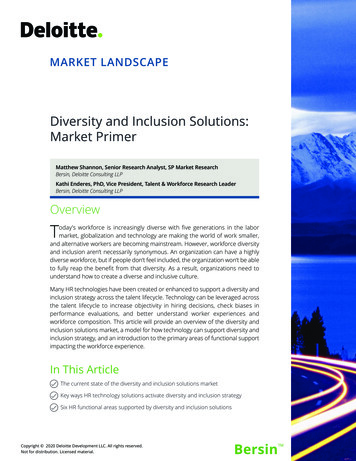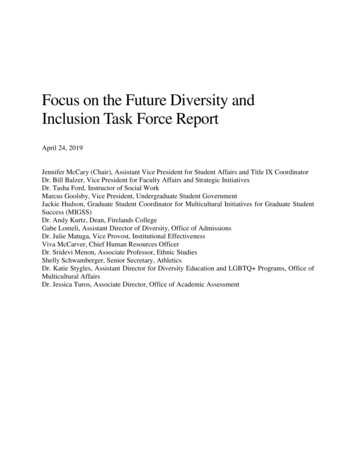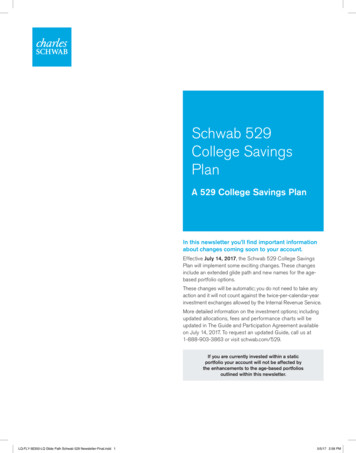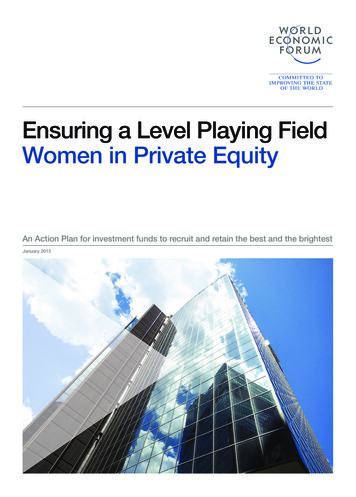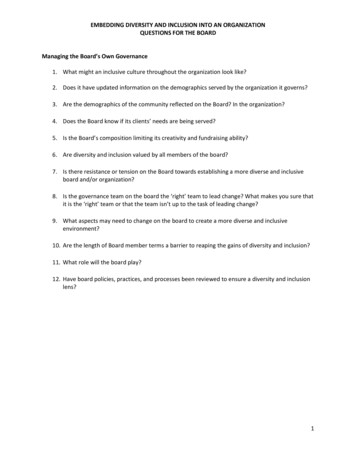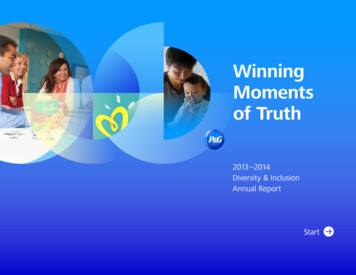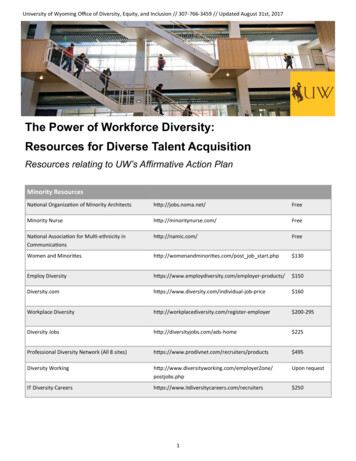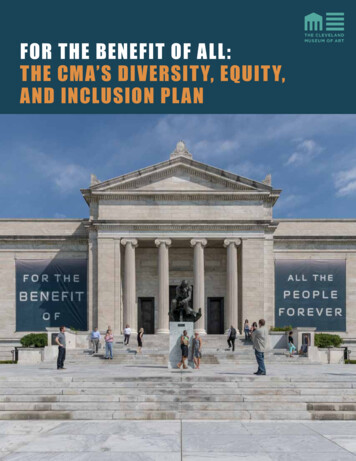
Transcription
FOR THE BENEFIT OF ALL:THE CMA’S DIVERSIT Y, EQUIT Y,AND INCLUSION PLAN1
2
CONTENTS4 Executive Summary7 Critical Success Factors8 Mission and Guiding Principles9 Our Vision, Our Mission, Our Promise10 Organizational Values11 Leadership Values13 Diversity, Equity, and Inclusion: Definitions14 Strategic Road Map18 Activating the Plan3
EXECUTIVE SUMMARYMore than a century ago, the Cleveland Museum of Art was established“for the benefit of all the people forever.” As a comprehensive art museum,dedicated to the art of every culture, place, and period, diversity is a corevalue. Yet, despite the fact that the CMA welcomes more than 600,000visitors annually and offers free admission, it has yet to touch the lives ofmany Clevelanders. Persons of color constitute more than 66% of Cleveland’spopulation (and about 30% of that of Cuyahoga County), but just 24% ofour attendance. This discrepancy must be addressed, as must the lack ofdiversity in our profession, especially as it pertains to executive andcuratorial positions.If we are to be a global leader among museums—if we are to succeed inmaking our collection broadly relevant, in expanding our audience, and inserving the ever more diverse population of our county and our countryas a whole—it is essential that we seek and offer new perspectives on ourmultifaceted collection, reaching out to and engaging visitors who may notknow or feel that they are welcome.The CMA’s Diversity, Equity, and Inclusion Plan dovetails with its 2017 strategicplan, Making Art Matter. Together, they provide a road map for betterconnecting with all audiences and for building trust through partnership. Weare committed to making the changes that will be required to move us closerto equity in our staffing, business practices, and public engagement efforts.Museums anchor the communities they serve. Historically seen as keepersof cultural memory, sources of credible information, and mentors forlifelong learning, they wield significant influence and bear commensurateresponsibility. The following plan defines the strategies and tactics that will berequired if the CMA is to accomplish the purpose for which it was founded:TO BECOME A GLOBAL LEADER AMONG MUSEUMS.4
In order to achieve this goal, we have establishedthese institutional success strategies:Champion Equity. Institutional policies and practices will help to eliminatebarriers to participation for historically underrepresented groups.Advance Cultural Competence. We will ensure that every aspect ofour recruitment, hiring, training, advancement, and retention practices areequitable, as measured by our leadership and staff that reflect the diversitywe value and the inclusivity to which we aspire.Extend a Universal Welcome. By forging new pathways to engagementboth within and outside the museum, we will increase the participationof historically underserved communities by fostering a diverse staff thatis fully invested in inclusive practices through programming, collections,and exhibitions.5
6
CRITICAL SUCCESS FACTORSThe following factors are critical to thesuccess and ongoing maintenance of theDiversity, Equity, and Inclusion Plan.Executive Sponsorship. The DEI Plan was developed in collaborationwith the CMA’s executive leadership, trustees, and staff. This plan dovetailswith the museum’s strategic plan and augments its diversity, equity, andinclusion goals and measurements. Full support and intentional effortsfrom the board of trustees and executive team are required to successfullyimplement the plan.Continued Strategic Alignment. Reflecting the institutionalpriorities at the time when it was developed, the DEI Plan is closely alignedwith the formulation of the museum’s strategic plan. As the museumevolves and the priorities change, the mission, strategies, and goals ofthis plan will be revisited.Partnership. The CMA’s goals for improving diversity, equity, and inclusionwithin the areas of talent and community will require strong partnershipsat both the local and national level.Resource Consideration. To optimize the organizational outcomesof the DEI Plan, the CMA will allocate resources accordingly to supportthe activities within the road map.Measurement and Reporting. A key element of effectivelyevaluating the ongoing success of the DEI Plan will be establishingbenchmarks and measuring progress against the museum’s goals.7
MISSION ANDGUIDING PRINCIPLESThe DEI Plan is integral to the CMA achievingits vision and mission statements, fulfillingits promise, and upholding its organizationaland leadership values.8
OUR VISIONTo be a global leader among museums.OUR MISSIONThe Cleveland Museum of Art createstransformative experiences through art,for the benefit of all the people forever.OUR PROMISEThe Cleveland Museum of Art offers dynamicexperiences that illuminate the power andenduring relevance of art in today’s globalsociety. The museum builds, preserves, studies,and shares its outstanding collections of artfrom all periods and parts of the world,generating new scholarship and understanding,while serving as a social and intellectual hubfor its community.9
ORGANIZATIONAL VALUESThe mission, values, and goals of the museumwill be at the forefront of all our decisionsand will be the guidepost for allocating ourresources. Be a community anchor and a beacon for thevisual arts. Build an audience-centered culture. Seek knowledge and generate newscholarship in the service of humanity. Recognize and celebrate the value ofdiversity. Be a strong and reliable partner, andcultivate collaborative relationships. Embrace thoughtful risk-taking andexperimentation. Communicate openly and hold ourselvesaccountable to one another, our supporters,and all our audiences.10
LEADERSHIP VALUESWe will lead by example and always beguided by the museum’s mission. Lead with courage tempered by humility. Be responsive, and listen and communicateclearly and consistently. Be transparent about our decisions andcommitted to fairness and accountability. Value constructive inquiry and embracediversity of thought. Honor dedication and diverse expertise,and value collaboration. Encourage innovation and make room forrisk-taking.11
InclusionEquityDiversityInclusive institutional policies and practicesensure that121the CMA’s staff and visitors have equitableopportunity and access to the CMA’sresources, and2the CMA is enriched by the diversity of itsstaff and visitors.
DIVERSITYThe characteristics that make one individualor group different from another, such asrace, ethnicity, gender, sexual orientation,nationality, religion, socioeconomic status,educational status, marital status, language,age, and mental or physical ability. Also, theinteractions among individuals that shapeideas, perspectives, and values.EQUITYThe outcome of policies and actions thatcreate a more diverse and inclusiveinstitution that reflects its community.INCLUSIONThe confrontation of historical exclusionbased on race, gender, sexual orientation,and economic status by bringing thoseaffected into institutional activities anddecision-making to address disparities,increase awareness, and fosterunderstanding.13
STRATEGIC ROAD MAPARTPresent art and programs that connect to current events and issuesthat impact people’s lives in order to broaden the museum’s reachand relevance.Survey and track the CMA’s acquisitions and exhibitions to determinethe representation of historically marginalized people.Assign a community engagement specialist to the interpretationteam in order to help us better speak to new audiences throughgallery text and app content.Use digital, social media, and print publication platforms to presentdiverse perspectives on art.PLACEIntegrate universal design principles throughout the museum to makeeach visitor feel welcome.Conduct an accessibility audit and establish a timeline for newinitiatives that better accommodate all audiences and that reflectbest practices in the field.Launch the Grounds Master Plan, which will incorporate a communityengagement process, with the goal of maximizing the use of outdoorspace and ensuring it is safe, vibrant, and welcoming for all visitors.14
AUDIENCECultivate partnerships with civic, cultural, and educationalinstitutions to build our audience and develop programs thataddress issues of equity and inclusion in the arts.Develop marketing and communication strategies to effectivelyreach first-time and occasional visitors in order to build sustainedrelationships.Monitor audience satisfaction data to identify and address recurrentDEI-related issues.To excite new and existing audiences, offer a broad range ofprograms that serve as an introduction to what the museum offers.Solicit and apply feedback from target audiences to identify areasof interest and to develop dynamic programming.RESOURCESDevelop and distribute a set of DEI measures that track themuseum’s progress against key metrics, and integrate data intodashboard reports.Seek contracts with diverse vendors across a broad range of services.Build DEI training into departmental budgets and schedules.Seek funding partners to support outreach programs that connect withneighborhoods across the region and that invite them to the CMA.Research, pilot, and implement new approaches to visitor engagementin the galleries, considering the roles of security, visitor services, andvolunteers.15
ORGANIZATIONAL CULTUREEstablish a multifunctional, cross-departmental DEI group tostrategize, monitor, and advise the CMA’s efforts, holding ourselvesaccountable to one another, our supporters, and all audiences.Research and develop staff training programs to deepen andextend understanding of diversity, equity, and inclusion. Surveystaff to evaluate effectiveness.Recruit, develop, and retain high-performing, talented employeeswith diverse backgrounds and perspectives to ensure the CMA’sposition as a global leader among museums.Research and pilot new applicant pipelines and recruitment tacticslocally, regionally, and nationally to increase the number of diverseapplicants.Track and review demographics of search outcomes (e.g., how manyapplied, who applied, who received offers, who accepted) viacomprehensive data collection to increase accountability amongmanagers.Establish talent management programs to accomplish DEI goals,such as succession planning, coaching, and mentoring to maximizeperformance and career potential.Make staff aware of the channels through which they can voiceconcerns and ask questions regarding aspects of diversity, equity,and inclusion.Communicate the importance of equity and inclusion in stafforientations and trainings by connecting participation in thetrainings to annual performance reviews.Develop and implement fellowship and internship programs todrive improved workforce representation.Establish a system of recognition for work related to DEI.16
17
ACTIVATING THE PL ANWITHIN THE NEXT TWO YEARS, WE WILL: Augment the collection with works by women artists andartists of color, and organize or host at least one exhibitionon a related theme every year. Create fellowship opportunities for graduate students toresearch and document the CMA’s acquisition andexhibition of work by women artists and artists of color. Develop an ArtLens tour of works by African Americanartists and create a designated web page; publish thefirst of a series of books by leading historians of AfricanAmerican art, generating new perspectives on the CMA’scollection. Train college students from diverse racial and economicbackgrounds to offer tours of the museum, in order thatthe CMA’s frontline educators better reflect the diversityof Greater Cleveland. Create a multitiered mentorship and fellowship program forhigh school through graduate students from underrepresentedminority backgrounds to encourage the pursuit of museumcareers. Present studio art classes and gallery tours in Spanish atthe CMA, to reach new audiences and minimize existinglanguage barriers. Systematically bring to Cleveland artists, scholars, andthought leaders to address and encourage dialogueconcerning issues of equity and inclusion in the arts. Launch a Community Arts Center on the near west sidethat offers studio art workshops to neighboring communities.18
Publish an annual record of community engagementinitiatives and outcomes to make visible the scope andreach of the CMA’s efforts. Target marketing and program design efforts on buildingnew audiences, so that visitorship increasingly reflectsthe demographics of the Cleveland–Elyria MetropolitanStatistical Area and Cuyahoga County statistical data. Partner with neighboring cultural organizations includingCleveland Public Library and Karamu House in order tobuild trust and relationships with new audiences. Develop a shared database of minority-owned businesses andcontractors and distribute broadly across the organization,stipulating that the CMA choose vendors that reflect thediversity of its community. Implement diversity, equity, and inclusion training for allmuseum staff. Establish a staff team to identify and address issues relatedto diversity, equity, and inclusion as they pertain to the visitorexperience, using visitor comment cards and survey data asa starting point. Identify best practices for Visitor Experience staff in yearone, and launch and evaluate pilot programs in year two. Effective immediately, require that there be a diversepool of candidates for every position, at every level of theorganization.19
20
More than a century ago, the Cleveland Museum of Art was established “for the benefit of all the people forever.” As a comprehensive art museum, dedicated to the art of every culture, place, and period, di

